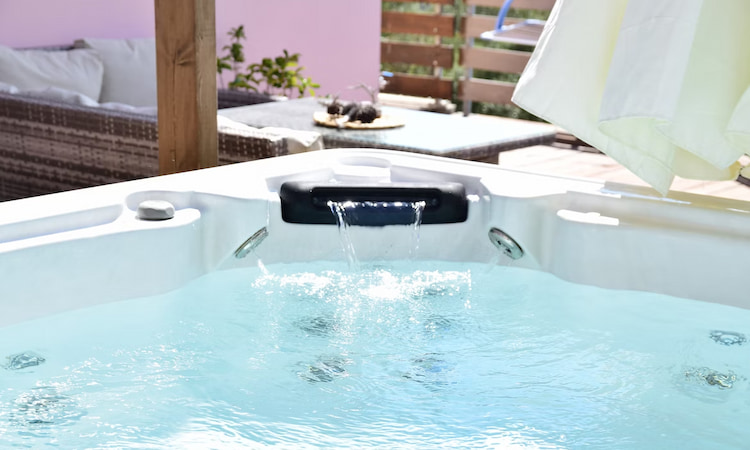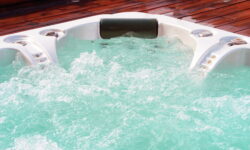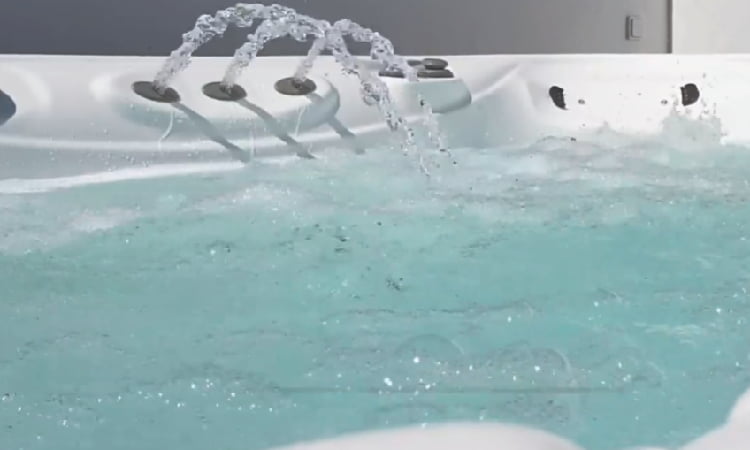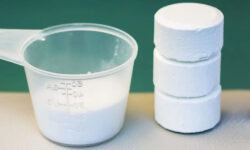You’ve got your hot tub, but do you understand the role of a stabilizer in it? It’s more than just keeping the water clean. Stabilizers balance your hot tub’s pH levels, making your soaks more enjoyable.
A stabilizer in a hot tub, often referred to as cyanuric acid, is a chemical used to prolong the lifespan of chlorine in the water. It works by bonding with chlorine and creating a sort of shield against the sun’s ultraviolet rays, which can rapidly deplete chlorine levels. Therefore, a stabilizer is essential for outdoor hot tubs as it maintains the effectiveness of the sanitizer (chlorine), leading to cleaner and safer water.
Let’s dive in to uncover the science behind these crucial additives, the types available, and how you can expertly use and maintain them. Brace yourself for potential problems and learn the tricks to keep your hot tub in perfect condition.

Quick Navigation
- Understanding the Role of a Stabilizer in a Hot Tub
- The Science Behind Hot Tub Stabilizers
- Types of Stabilizers Used in Hot Tubs
- How to Properly Use Stabilizers in Your Hot Tub
- Potential Problems With Hot Tub Stabilizers
- Tips for Maintaining Optimal Stabilizer Levels in Your Hot Tub
- Frequently Asked Questions
- Conclusion
Understanding the Role of a Stabilizer in a Hot Tub
You’ll find that a stabilizer plays a crucial role in maintaining the chemical balance of your hot tub’s water. It’s a key player in ensuring your hot tub remains a safe and enjoyable environment. Ever wondered why the chlorine levels fluctuate even after you’ve just added some? It’s likely because you’re missing a stabilizer.
The stabilizer, also known as cyanuric acid, helps to slow down the rate at which chlorine is destroyed by the ultraviolet rays of the sun. Without it, you’ll be using more chlorine than necessary, which can lead to unnecessary expenses and the potential for imbalanced water chemistry.
Remember, too much or too little of any chemical can lead to problems, from skin irritation to damage to the hot tub itself. That’s where the stabilizer comes in. It helps keep the chlorine levels steady, making your maintenance job easier and your hot tub more enjoyable.
The Science Behind Hot Tub Stabilizers
Understanding the science behind hot tub stabilizers is crucial to maintaining a safe and enjoyable hot tub experience. Let’s first explore the chemical composition of these stabilizers, then we’ll move on to how they function and their potential impact on your health. This knowledge will not only keep your hot tub in top shape but also ensure your well-being.
Stabilizer Chemical Composition
Before we dive into the specifics, let’s take a moment to look at the science behind the chemical composition of hot tub stabilizers. These are unique compounds that help maintain the quality and safety of your hot tub water.
They’re primarily composed of:
- Cyanuric Acid: This is the primary active ingredient. It protects chlorine from UV rays, prolonging its effectiveness.
- Sodium: Often used to balance pH levels.
- Borate: Used to control algae growth.
- Additional ingredients: These may vary depending on the brand, but can include binders and fillers.
Understanding these components can help you make informed decisions about which stabilizer is best for your hot tub. Remember, a well-maintained hot tub is the key to ensuring a relaxing and healthy soak.
Stabilizer Functioning Mechanism
Now, let’s delve into how hot tub stabilizers actually work to keep your water clean and safe. Stabilizers primarily function to protect the chlorine in your tub from the sun’s UV rays. The chlorine would rapidly break down without a stabilizer, reducing its effectiveness.
Here’s a simple table to illustrate this:
| Action | Without Stabilizer | With Stabilizer |
|---|---|---|
| UV Exposure | Chlorine breaks down rapidly | Chlorine lasts longer |
| Chlorine Efficacy | Low, needs frequent replenishing | High, lasts longer |
| Water Safety | Can become unsafe quickly | Remains safe for longer |
Stabilizer Impact on Health
Diving into the science behind hot tub stabilizers, you’ll discover their impact on health and wellness, but it’s important to note that balance is key. These substances help maintain the right pH levels, preventing harmful bacteria growth. However, too much can lead to issues. Here’s a quick rundown:
Types of Stabilizers Used in Hot Tubs
You’ll find a range of stabilizers available for your hot tub, each with unique benefits and drawbacks. Commonly used ones are chlorine-based stabilizers, which are known for their effectiveness, and bromine, favored for its gentleness on skin. But don’t disregard alternative options either, they might offer the balance you’re looking for.
1. Chlorine-based Stabilizers
In your quest for hot tub maintenance, it’s essential to understand the role of chlorine-based stabilizers, a type of chemical used to maintain the purity of your hot tub’s water. Chlorine stabilizers, also known as cyanuric acid, protect the chlorine from the sun’s UV rays, which can rapidly deplete the chlorine levels in your hot tub.
Here are some key facts about chlorine-based stabilizers:
- They help to maintain a consistent level of chlorine in your hot tub.
- Without them, you’d have to add chlorine more frequently, leading to higher maintenance costs.
- Overuse of chlorine stabilizers can reduce the effectiveness of chlorine.
- It’s important to regularly test your hot tub’s water to ensure the stabilizer levels are appropriate.

2. Bromine as a Stabilizer
Besides chlorine, you’ll also find bromine as a common stabilizer in hot tubs, and it’s important to understand how it works. Bromine, like chlorine, is a halogen and acts as an effective disinfectant.
However, it’s distinctly different in its mode of action. Bromine tends to be more stable at higher temperatures, making it an ideal choice for hot tubs. It’s also less irritating to the skin and eyes. Bromine tablets dissolve slowly in water, maintaining a constant level of sanitizer.
But, you should be aware that bromine isn’t as reactive as chlorine, so it might not kill bacteria and viruses as quickly. Despite this, many hot tub owners prefer bromine because it provides a less noticeable odor and is gentler on bathing suits and spa equipment.
3. Alternative Stabilizer Options
Exploring alternative stabilizer options for your hot tub, you’ll come across a variety of types, and it’s crucial to understand their benefits and drawbacks. Each has its unique characteristics suited to different needs.
- Chlorine: It’s the most common type, effective but can cause skin and eye irritation.
- Mineral purifiers: These use minerals like silver or copper. They’re gentler on the skin but require additional sanitizer.
- Ozone generators: These use oxygen molecules to destroy contaminants. They’re efficient but expensive.
- UV light systems: These kill bacteria using UV light. They’re eco-friendly but don’t prevent algae.
How to Properly Use Stabilizers in Your Hot Tub
Surprisingly, you’ll find that using stabilizers in your hot tub correctly can significantly enhance your tub’s performance and longevity. These chemicals help maintain a consistent pH level, preventing damage to the tub’s inner workings and providing a more enjoyable soaking experience.
To use stabilizers properly, first, you’ll need to test the water. This will allow you to determine the current pH level and whether it’s necessary to add a stabilizer. Testing kits are readily available at pool and spa stores, or online.
Once you’ve determined the need for a stabilizer, add it directly to the hot tub. The amount you’ll use depends on the size of your hot tub and the current pH level. Instructions on the stabilizer package should provide a clear guideline. After adding the stabilizer, let the hot tub run for a few hours. This will ensure the chemical is thoroughly mixed into the water.
Remember to retest the water after the stabilizer has been added. If the pH level is within the desired range, you’re good to go. If not, you may need to add more stabilizers or consult with a professional. Proper use of stabilizers will keep your hot tub running smoothly for years to come.
Related Read: How to Lower Cyanuric Acid in a Hot Tub?
Potential Problems With Hot Tub Stabilizers
While you might think stabilizers are always beneficial, there’s a chance you’ll encounter some issues when using them in your hot tub. Just like any other chemical, stabilizers need to be used with caution. Overuse or misuse of these substances can lead to various complications.
Here are some potential problems you might face:
- Imbalances in water chemistry: Too much stabilizer can disrupt the water balance, affecting the effectiveness of other chemicals and making the water unsafe for use.
- Skin and eye irritation: High levels of stabilizer can cause excessive dryness and irritation to your skin and eyes.
- Damage to hot tub parts: Excessive stabilizer can lead to build-up and corrosion, damaging your hot tub’s parts over time.
- Difficulty in sanitizing: Over-stabilized water can resist the sanitizing effect of chlorine, leading to a build-up of bacteria and algae.
Therefore, while stabilizers are essential in maintaining the longevity of your hot tub, they should always be used responsibly. Regular testing and carefully adjusting your hot tub’s water chemistry are crucial in preventing these potential problems.
Tips for Maintaining Optimal Stabilizer Levels in Your Hot Tub
You’ll find that maintaining optimal stabilizer levels in your hot tub isn’t as complicated as it sounds, especially when you have a water testing kit at your disposal. This essential tool helps you gauge the current stabilizer levels, ensuring that they are within the recommended range.
However, testing alone won’t keep your hot tub in check. Regular maintenance is also crucial. Aim to balance your hot tub’s water at least once a week. Adjust the stabilizer levels as needed, based on the results from your water testing kit. Remember, too much or too little stabilizer can result in problems such as cloudy water or ineffective sanitization.
Another tip is to keep your hot tub covered when not in use. This simple practice reduces the loss of stabilizer due to evaporation and helps to maintain a consistent level.
Lastly, be mindful of heavy usage periods or after adding large amounts of fresh water. These situations can significantly alter the stabilizer level, necessitating a readjustment. By following these straightforward tips, you’ll ensure that your hot tub remains a safe and enjoyable retreat for all users.
Frequently Asked Questions
Stabilizer costs for your hot tub aren’t overly expensive. You’ll spend on initial purchases, typically under $20, and regular refills. Remember, it’s an essential part of maintenance to keep your water balanced and clean.
Yes, you can use a hot tub without a stabilizer. However, it’s riskier as the water’s pH levels could fluctuate, possibly damaging the tub. Also, it may affect your comfort and health while using it.
Yes, there are natural alternatives to traditional hot tub stabilizers. You can opt for mineral purifiers or ozonators. They’re eco-friendly, reduce chemical usage, and are safe for your skin and eyes. Always research before switching.
Yes, professionals often recommend brands like Leisure Time, SpaGuard, and Clorox Pool&Spa. They’re known for their effectiveness and reliability. However, your choice should depend on your hot tub’s specific needs and chemistry.
You should check your hot tub’s stabilizer level regularly, ideally weekly. If it’s low, replenish it. However, the frequency can depend on tub usage. Always refer to the stabilizer’s label for specific instructions.
Conclusion
So, now you know the ins and outs of hot tub stabilizers. They’re key for keeping your hot tub clean and safe, but it’s crucial to use them properly. If you’re mindful of potential issues and stay on top of your stabilizer levels, you’ll ensure a great hot tub experience.
Remember, a well-maintained hot tub is the key to relaxation and enjoyment. Happy hot tubbing!




![Can You Over Shock a Hot Tub? [What to Do if You Did?] can you over shock a hot tub](https://hottubtales.com/wp-content/uploads/2023/10/can-you-over-shock-a-hot-tub-250x150.jpg)

